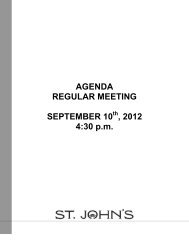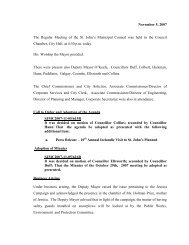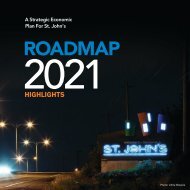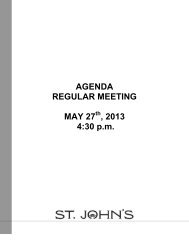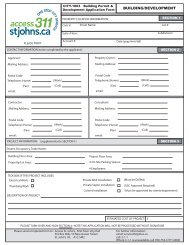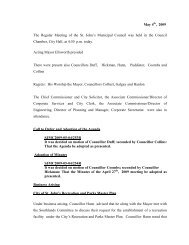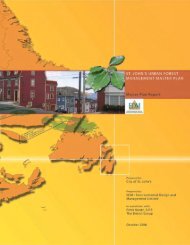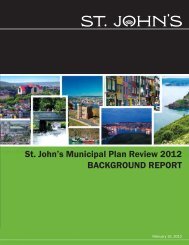- Page 1:
Metrobus Market Assessment and Stra
- Page 4 and 5:
St. John’s Transportation Commiss
- Page 6 and 7:
St. John’s Transportation Commiss
- Page 8 and 9:
St. John’s Transportation Commiss
- Page 10 and 11: St. John’s Transportation Commiss
- Page 12 and 13: St. John’s Transportation Commiss
- Page 14 and 15: St. John’s Transportation Commiss
- Page 16 and 17: St. John’s Transportation Commiss
- Page 18 and 19: St. John’s Transportation Commiss
- Page 20 and 21: St. John’s Transportation Commiss
- Page 22 and 23: St. John’s Transportation Commiss
- Page 24 and 25: St. John’s Transportation Commiss
- Page 26 and 27: St. John’s Transportation Commiss
- Page 28 and 29: St. John’s Transportation Commiss
- Page 30 and 31: St. John’s Transportation Commiss
- Page 32 and 33: St. John’s Transportation Commiss
- Page 34 and 35: St. John’s Transportation Commiss
- Page 36 and 37: St. John’s Transportation Commiss
- Page 38 and 39: St. John’s Transportation Commiss
- Page 40 and 41: St. John’s Transportation Commiss
- Page 42 and 43: St. John’s Transportation Commiss
- Page 44 and 45: St. John’s Transportation Commiss
- Page 46 and 47: St. John’s Transportation Commiss
- Page 48 and 49: St. John’s Transportation Commiss
- Page 50 and 51: St. John’s Transportation Commiss
- Page 52 and 53: St. John’s Transportation Commiss
- Page 54 and 55: St. John’s Transportation Commiss
- Page 56 and 57: St. John’s Transportation Commiss
- Page 58 and 59: St. John’s Transportation Commiss
- Page 62 and 63: St. John’s Transportation Commiss
- Page 64 and 65: St. John’s Transportation Commiss
- Page 66 and 67: St. John’s Transportation Commiss
- Page 68 and 69: St. John’s Transportation Commiss
- Page 70 and 71: St. John’s Transportation Commiss
- Page 72 and 73: St. John’s Transportation Commiss
- Page 74 and 75: St. John’s Transportation Commiss
- Page 76 and 77: St. John’s Transportation Commiss
- Page 78 and 79: St. John’s Transportation Commiss
- Page 80 and 81: St. John’s Transportation Commiss
- Page 82 and 83: St. John’s Transportation Commiss
- Page 84 and 85: St. John’s Transportation Commiss
- Page 86 and 87: St. John’s Transportation Commiss
- Page 88 and 89: St. John’s Transportation Commiss
- Page 90 and 91: St. John’s Transportation Commiss
- Page 92 and 93: St. John’s Transportation Commiss
- Page 94 and 95: St. John’s Transportation Commiss
- Page 96 and 97: St. John’s Transportation Commiss
- Page 98 and 99: St. John’s Transportation Commiss
- Page 100 and 101: St. John’s Transportation Commiss
- Page 102 and 103: St. John’s Transportation Commiss
- Page 104 and 105: St. John’s Transportation Commiss
- Page 106 and 107: St. John’s Transportation Commiss
- Page 108 and 109: St. John’s Transportation Commiss
- Page 110 and 111:
St. John’s Transportation Commiss
- Page 112 and 113:
St. John’s Transportation Commiss
- Page 114 and 115:
St. John’s Transportation Commiss
- Page 116 and 117:
St. John’s Transportation Commiss
- Page 118 and 119:
St. John’s Transportation Commiss
- Page 120 and 121:
St. John’s Transportation Commiss
- Page 122 and 123:
St. John’s Transportation Commiss
- Page 124 and 125:
St. John’s Transportation Commiss
- Page 126 and 127:
St. John’s Transportation Commiss
- Page 128 and 129:
St. John’s Transportation Commiss
- Page 130 and 131:
St. John’s Transportation Commiss
- Page 132:
APPENDIX A Online Questionnaire Sam
- Page 135 and 136:
Transit Use 1. Have you used Metrob
- Page 137 and 138:
3. Which of the following, if any,
- Page 139 and 140:
Transit Users 1. How long have you
- Page 141 and 142:
Transit Users 1. In the past 12 mon
- Page 143 and 144:
6. What is your primary purpose for
- Page 145 and 146:
2007 Service Change 1. Did you ride
- Page 147 and 148:
Contact Information 1. Please fill
- Page 149 and 150:
4. How many vehicles are available
- Page 152 and 153:
Metrobus Market Study and Strategic
- Page 154 and 155:
Metrobus Market Study and Strategic
- Page 156 and 157:
Metrobus Market Study and Strategic
- Page 158 and 159:
Metrobus Market Study and Strategic
- Page 160 and 161:
Metrobus Market Study and Strategic
- Page 162 and 163:
Metrobus Market Study and Strategic
- Page 164 and 165:
Metrobus Market Study and Strategic
- Page 166:
APPENDIX B CNA Student Survey and R
- Page 169 and 170:
Student Profile/Transit Use 1. Are
- Page 171 and 172:
Non Transit Users Off Campus 1. How
- Page 173 and 174:
Non Transit Users On Campus 1. What
- Page 175 and 176:
3. How do you normally pay for your
- Page 177 and 178:
Transit Users 1. What other trips d
- Page 179 and 180:
Universal Student Transit Pass One
- Page 182 and 183:
Metrobus Market Study and Strategic
- Page 184 and 185:
Metrobus Market Study and Strategic
- Page 186 and 187:
Metrobus Market Study and Strategic
- Page 188 and 189:
Metrobus Market Study and Strategic
- Page 190:
Metrobus Market Study and Strategic
- Page 194 and 195:
Introduction Metrobus is evaluating
- Page 196 and 197:
Student Profile/Transit Use 1. What
- Page 198 and 199:
Non Transit Users Off Campus 1. How
- Page 200 and 201:
Non Transit Users On Campus 1. What
- Page 202 and 203:
3. How do you normally pay for your
- Page 204 and 205:
Transit Users 1. What other trips d
- Page 206 and 207:
Universal Student Transit Pass One
- Page 208 and 209:
Metrobus Market Study and Strategic
- Page 210 and 211:
Metrobus Market Study and Strategic
- Page 212 and 213:
Metrobus Market Study and Strategic
- Page 214 and 215:
Metrobus Market Study and Strategic
- Page 216 and 217:
Metrobus Market Study and Strategic
- Page 218:
Metrobus Market Study and Strategic
- Page 222 and 223:
Introduction Metrobus is evaluating
- Page 224 and 225:
2. Main type of business activity:
- Page 226 and 227:
Relationship to Transit 1. Does you
- Page 228 and 229:
8. Would you CONSIDER participating
- Page 230:
Survey Completion Thank you for you
- Page 233 and 234:
Metrobus Market Study and Strategic
- Page 235 and 236:
Metrobus Market Study and Strategic
- Page 237 and 238:
Metrobus Market Study and Strategic
- Page 239 and 240:
Metrobus Market Study and Strategic
- Page 242:
APPENDIX E Onboard Passenger Survey
- Page 245 and 246:
Tell us about yourself and your tra
- Page 247 and 248:
Metrobus Market Study and Strategic
- Page 249 and 250:
Metrobus Market Study and Strategic
- Page 251 and 252:
Metrobus Market Study and Strategic
- Page 253 and 254:
Metrobus Market Study and Strategic
- Page 255 and 256:
Metrobus Market Study and Strategic
- Page 257 and 258:
Metrobus Market Study and Strategic
- Page 260:
APPENDIX F Peer Review Municipaliti
- Page 264:
APPENDIX G Off-Street Terminal Desi





